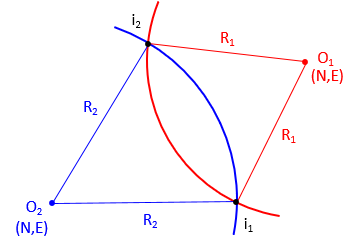2. Solution logic
A radius is a distance, Figure D-3, so the Forward Computation equations of any point on an arc can be written as Equations D-2 and D-3.
|
|
|
Figure D-3 |
| Equation D-2 | |
| Equation D-3 |
An arc-based intersection solution uses a radius for a distance. For example, Figure D-4 shows a distance-distance intersection using two known arc centers and two radii.
|
|
|
Figure D-4 |
A direction-distance intersection is similar except only a single radius is used. Generally, coordinates of the intersection point are determined by simultaneous solution of Equations D-1, D-2, and D-3. A direction-direction intersection does not use distances so only Equations D-2 and D-3 are needed.
The disadvantages of the arc-based approach are:
- For someone new to COGO, solving intersections using triangles is simple and intuitive, using arcs is less so
- Coordinate solutions can involve numerous equations creating potential for computational errors
- Errors could also be easily introduced if coordinate orders in the equations are reversed
On the other hand:
- A triangle-based solution requires the user to decide what geometry to solve based on measurements provided and which position to solve; arc-based coordinate equations are general so they are just plug-and-chug
- Where there are two possible intersection solutions, both can be solved with little additional effort
- Arc-based solutions are computationally efficient, particularly for programming or spreadsheet applications
- Other types of problems, such as curve fitting, are easier to solve using arc-based methods
Because arcs are not linear, intersections involving them require solving a second degree polynomial, Equation D-4. A second degree polynomial has two possible answers which are determined using a quadratic solution, Equation D-5.
| Equation D-4 | |
| Equation D-5 |
That means there are two intersection points when at least one measurement is an arc. We saw that in the triangle-based methods: distance-distance and direction-distance had two possible intersections, direction-direction did not.
Triangle-based and arc-based intersections have the same known positions and connecting measurement requirements. They differ only in how the data are manipulated to get the same results. To maintain consistency with previously described triangle-based solutions, points J and K will be used as known control points in the arc-based discussion.

